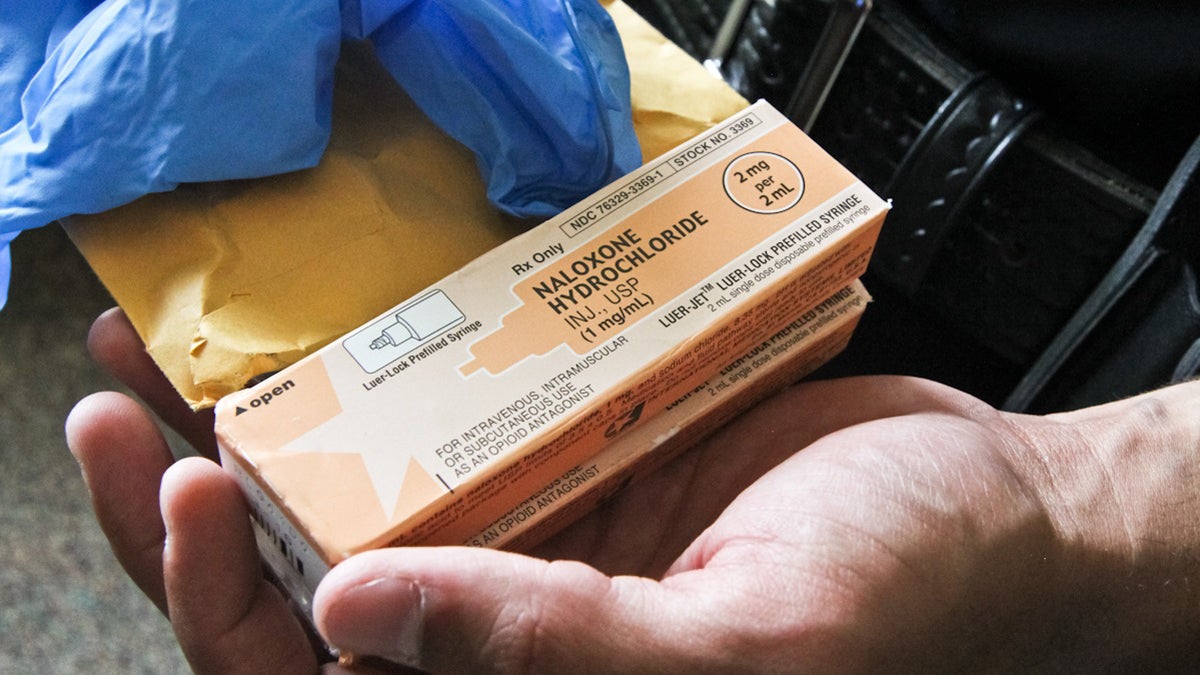The overdose ‘antidote’: how Narcan works
Listen 3:50
(Kimberly Paynter/for WHYY)
Nalaxone or Narcan is one powerful drug, with powerful, immediate effects. So how does this lifesaving drug actually work?
It comes in liquid form, administered through a syringe, and in the case of Camden County police officers, via nasal spray.
The drug is technically referred to as an ‘antagonist,’ explains Tom Ferraro, professor of biomedical sciences at Cooper Medical School of Rowan University in Camden, N.J. and it essentially “blocks the ability of opioids to do what they do at the molecular level.”
Your brain on drugs
The proteins in your brain have special receptors that, when unlocked, release certain biochemical reactions. Think of opioids, like heroin, as being special keys, says Ferraro. When they get in your brain, they seek out those receptors, “latch on” and unlock the lock. When the drug opens and closes that lock repeatedly, it “triggers a cascade of biochemistry inside that particular cell.”
This is the basic mechanism of being high. The heroin repeatedly unlocks the lock, releasing euphoria, pain relief and addiction from that cell.
But it also tells your body to slow down.
Take too much of an opioid? Those keys “flood the locks” in your brain. With that, your breathing and heart rate “slow down too slow,” says Ferraro.
And there you have an overdose.
“His lips were blue, his fingertips were blue, he was sweating profusely,” recalls Camden County police officer Maureen Baney, of a recent incident. “He almost looked like he was dead.”
Enter Narcan
Think of Narcan as a key, says Ferraro, that scientists cut to specially fit those locks that heroin and other opioids like. But when it gets in those locks, it acts differently.
“It’s able to, just like morphine, bind, but it doesn’t unlock,” says Ferraro. “So it attaches but it’s not able to trigger the cascade of effects inside the cell.”
It just sits there, blocking the opioid’s access to the lock, “and so you outcompete” the opioids.
The process happens extremely quickly.
“It’s like a countdown,” recalls Baney. “The ones I witnessed, less than 30 seconds, it works.”
So if the Narcan is administered soon enough, that slow heart rate and even unconsciousness are reversed.
“Literally it was like, ‘watch, it’s going to be like a mummy,’ says Baney. “They were dead, they weren’t breathing, and they administered it, and [the person overdosing] sat straight up, and asked where they were.”
“It truly is an antidote,” says Ferraro.
Doctors and others do worry about two things.
A really potent dose of heroin or another opioid could outlast Narcan, and the overdose could come back.
“Nalaxone only lasts for about 45 minutes, so for patients who use heroin or fentanyl, the drug itself can last longer than the Nalaxone, so they could have a recurrence of depressed mental status,” says Cooper Hospital emergency physician and toxicologist Matthew Salzman.
For that reason, medical personnel try to watch a person for at least two hours after the Nalaxone is administered. Another reason Salzman and others want to keep watch is more immediately, when the drug reverses and overdose, it reverses all the opioid effects, meaning a person immediately enters withdrawal.
“For most patients, it’s not a life threatening illness. It’s very uncomfortable. There’s a lot of vomiting and diarrhea, sweatiness, a general feeling of not well,” says Salzman. “But for older patients who are on chronic opioid therapy, if you give them a high dose of nalaxone, you can actually put significant stress on the body by taking away all that essentially pain management, that could have adverse events happen, like heart attacks.”
Baney says officers sometimes get the brunt of the withdrawal. After she recently gave narcan to a man overdosing, “they said ‘why the ‘f’ would you do that, you messed up my high.’ But they weren’t even alive [before] when [the overdose] was happening.”
Even so, “it was a neat experience to be able to save somebody’s life,” says Baney.
WHYY is your source for fact-based, in-depth journalism and information. As a nonprofit organization, we rely on financial support from readers like you. Please give today.






